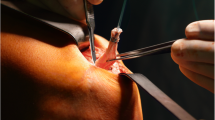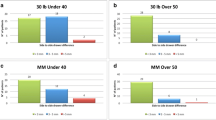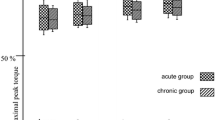Abstract
Between September 1987 and November 1989, we treated 90 consecutive patients with an acute anterior cruciate ligament (ACL) rupture with the multiple suture technique and iliotibial band augmentation. Seventy of these patients were re-examined 2 to 5 years after the operation (mean 3.5 years), the examination consisting of a questionnaire, clinical examination, laxity tests with the KSS machine (Acufex), radiological examination and isokinetic muscle strength testing (Cybex 6000). There were 32 men and 38 women (mean age 34 years). The injury was sustained in sports in 44 (63%) cases, and the sports most frequently involved were downhill skiing (18 cases), soccer (9 cases) and volleyball (5 cases). Of the injuries, 38 were isolated ACL ruptures and 31, ACL ruptures combined with a medial CL rupture. In 9 cases, an additional meniscus injury and in one case an additional posterior CL - lateral CL rupture was found. At the follow-up, 55 patients (79%) were satisfied with the end result, and according to our objective functional criteria 55 (79%) had an excellent or good outcome. According to the Lysholm score, 53 (76%) patients were excellent or good (⩾ 82 points). In the Lachman test, 29 knees (41%) were completely stable. The Lachman test was mildy positive in 40 knees (57%) (36 had 1+ laxity and 4, 2+ laxity), and one patient had 3+ laxity with a hard end-point. Similarly, the anterior drawer test was negative in 53 knees (76%); and the other 17 (24%) had mild laxity (16 had 1+ laxity and 1, 2+ laxity). The total anterior-posterior laxity measured with the KSS averaged 9.7 ± 3.5 mm in the injured knee and 7.3 + 3.0 mm in the uninjured knee (the laxity measured at a knee angle of 20° of flexion). Corresponding values at a knee angle of 90° of flexion were 6.1 ± 2.4 mm and 4.7 ± 1.9 mm, respectively. The pivot shift test was negative in 62 patients (89%) and l+ positive in the remaining 8 patients (11%). Fifty-eight patients (83%) had full knee extension and 40 patients (57%), full knee flexion. Compared with the uninjured knee, the operated knees showed an average 14% strength deficit in isokinetic knee extension and 6% deficit in flexion at the speed of 60°/s. At the speed of 180°/s, the corresponding deficits were 8% and 4%, respectively. Of the 44 patients who were active in sport before the injury, 40 (91%) were able to return to sports. A flexion deficit of 5° or more was associated with thigh muscle atrophy (P < 0.05) and quadriceps weakness, both at the slow speed (P < 0.05) and high speed (P < 0.001) of the isokinetic movement. In conclusion, in an acute rupture of the ACL, primary repair of the ligament with intraarticular iliotibial band augmentation seems to be a good method to restore the functional capacity of the injured knee.
Similar content being viewed by others
References
Andersson C, Gillquist J (1992) Treatment of acute isolated and combined ruptures of the anterior cruciate ligament. A longterm follow-up study. Am J Sports Med 20:7–12
Andersson C, Odenstein M, Good L, Gillquist J (1989) Surgical or non-surgical treatment of acute rupture of the anterior cruciate ligament. A randomized study with long-term followup. J Bone Joint Surg [Am] 71:965–970
Andersson C, Odensten M, Gillquist J (1991) Knee function after surgical or nonsurgical treatment of acute rupture of the anterior cruciate ligament: a randomized study with a long-term follow-up period. Clin Orthop 264:255–263
Dahlstedt L, Dalen N (1993) Anterior cruciate-injured knees: a review of evaluation methods and treatment regimens. Scand J Med Sci Sports 3:2–18
Dixon WJ, Brown MB, Engelman L, Jennrich RI (eds) (1990) BMDP statistical software manuals Vol l. University of California Press, Berkeley
Ekstrand J (1989) Reconstruction of the anterior cruciate ligament in athletes, using a fascia lata graft: a review with preliminary results of a new concept. Int J Sports Med 10:225–232
Engebretsen L, Benum P, Fasting O, Mölster A, Strand T (1990) A prospective randomized study of three surgical techniques for treatment of acute ruptures of the anterior cruciate ligament. Am J Sports Med 18:585–590
Gabaud HE, Feagin JA, Rodkey WG (1980) Acute anterior cruciate ligament injury and augmented repairs. Experimental studies. Am J Sports Med 8:395–401
Järvinen M, Kannus P (1985) Clinical and radiological long term results after primary knee ligament surgery. Arch Orthop Trauma Surg 104:1–5
Järvinen M, Kannus P, Johnson RJ (1991) How to treat knee ligament injuries? Ann Chirurg Gynaecol 80:134–140
Johnson RJ, Beynnon BD, Nichols CE, Renström PA (1992) The treatment of injuries of the anterior cruciate ligament. J Bone Joint Surg [Am] 74:140–151
Kannus P, Järvinen M (1987) Conservatively treated tears of the anterior cruciate ligament: long term results. J Bone Joint Surg [Am] 67:1007–1012
Kannus P, Järvinen M (1989) Posttraumatic anterior cruciate ligament insufficiency as a cause of osteoarthritis in a knee joint. Clin Rheumatol 8:251–260
Kannus P, Järvinen M, Paakkala T (1988) A radiological scoring scale for evaluation of post-traumatic osteoarthritis after knee ligament injuries. Int Orthop (SICOT) 12:291–297
Kannus P, Sievänen H, Järvinen M, Heinonen A, Oja P, Vuori I (1992) A cruciate ligament injury produces considerable, permanent osteoporosis in the affected knee. J Bone Min Res 7:1429–1434
Kaplan N, Wickiewicz TL, Warren RF (1990) Primary surgical treatment of anterior cruciate ligament ruptures. A long-term follow-up study. Am J Sports Med 18:354–358
Kleipool A, Van Loon T, Marti R (1994) Pain after use of the central third of the patellar tendon for cruciate ligament reconstruction. Acta Orthop Scand 65:62–66
Lysholm J, Gillquist J (1982) Evaluation of knee ligament surgery results with special emphasis on use of a scoring scale. Am J Sports Med 10:150–155
Marshall JL, Fetto JF, Botero BM (1977) Knee ligament injuries. A standardized evaluation method. Clin Orthop 123:641–645
Marshall JL, Warren RF, Wickiewicz TL (1979) The anterior cruciate ligament: a technique of repair and reconstruction. Clin Orthop 143:97–106
Marshall JL, Warren RF, Wickiewicz TL (1982) Primary surgical treatment of anterior cruciate ligament lesions. Am J Sports Med 10:103–107
Noyes FR, Butler DL, Grood ES, Zernicke RF, Hefzy M (1984) Biomechanical analysis of human ligament grafts used in knee-ligament repairs and reconstructions. J Bone Joint Surg [Am] 66:344–352
Noyes FR, Mooar PA, Matthews DS, Butler DL (1983) The symptomatic anterior cruciate-deficient knee. I. The long-term functional disability in athletically active individuals. J Bone Joint Surg [Am] 65:154–162
Odensten M, Lysholm J, Gillquist J (1983) Long-term followup study of a distal iliotibial band transfer (DIT) for anterolateral knee instability. Clin Orthop 176:129–135
Odensten M, Hamberg P, Nordin M, Lysholm J, Gillquist J (1985) Surgical or conservative treatment of the acutely torn anterior cruciate ligament. Clin Orthop 198:87–93
Renström P (1991) Sports traumatology today. A review of common current sports injury problems. Ann Chirurg Gynaecol 80:81–93
Rosenberg TD, Franklin JL, Baldwin GN, Nelson KA (1992) Extensor mechanism function after patellar tendon graft harvest for anterior cruciate ligament reconstruction. Am J Sports Med 20:519–526
Sachs RA, Daniel DM, Stone ML, Garfein RE (1989) Patellofemoral problems after anterior cruciate ligament reconstruction. Am J Sports Med 17:760–765
Shelboume KD, Nitz P (1990) Accelerated rehabilitation after anterior cruciate ligament reconstruction. Am J Sports Med 18: 292–299
Shelboume KD, Wilckens JH, Mollabashy A, DeCarlo M (1991) Arthrofibrosis in acute anterior cruciate ligament reconstruction. The effect of timing of reconstruction and rehabilitation. Am J Sports Med 19:332–336
Sherman M, Lieber L, Bonamo JR, Podesta L, Reiter I (1991) The long-term follow-up of primary anterior cruciate ligament repair. Defining a rationale for augmentation. Am J Sports Med 19:243–255
Shino K, Nakagava S, Inoue M, Horibe S, Yoneda M (1993) Deterioration of patellofemoral articular surfaces after anterior cruciate ligament reconstruction. Am J Sports Med 21:206–211
Sommerlath K, Lysholm J, Gillquist J (1991) The long-term course after treatment of acute anterior cruciate ligament ruptures. A 9 to 16 year follow-up. Am J Sports Med 19:156–162
Author information
Authors and Affiliations
Rights and permissions
About this article
Cite this article
Natri, A., Kannus, P. & Järvinen, M. Primary repair plus intra-articular iliotibial band augmentation in the treatment of an acute anterior cruciate ligament rupture. Arch Orthop Trauma Surg 115, 22–27 (1996). https://doi.org/10.1007/BF00453212
Received:
Issue Date:
DOI: https://doi.org/10.1007/BF00453212




